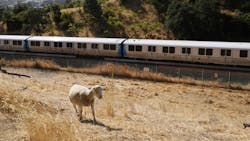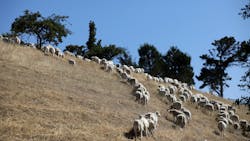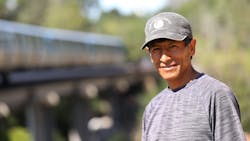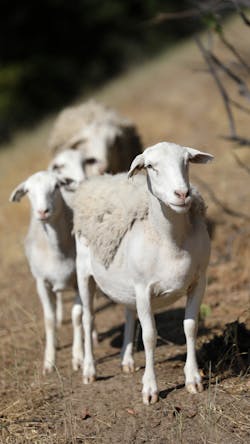Putting the 'Baaaa' in BART: BART welcomes a new animal to its fire mitigation toolkit
Bay Area Rapid Transit (BART) and it's unsung fire marshals: The goats and, recently, the sheep of the land, forged an alliance forged almost two years ago when BART found itself in need of a sustainable way to maintain the overgrown and dry grasses around BART's properties.
In the beginning, BART's firefighting brigade consisted of goats hired for their affinity to gravitate towards taller woody plants. BART has added a new animal to its fire mitigation arsenal: Self-shearing sheep. The sheep have clocked in to take care of the land's shorter grazing grasses and short roughage.
Sheep and goats belong to the same subfamily, Caprinae, and they both like to eat. It's beneficial to rotate the animals every few years, notes Mike Canaday, owner of the Coalinga-based Living Systems Land Management, from which BART contracts its fire-mitigating grazers.
“BART has been using goats for a while now, meaning there’s more fine grasses and less brush now,” Canaday said. “The sheep graze the grasses while the goats go for the coarser brittle.”
Josh Soltero, a Fence and Irrigation Technician at BART who supports the grazing project, has noticed some key personality differences in his time working with the animals.
“The sheep look like fluffy goats, but the goats are a little friendlier. They’ll come up to you and feel you out. The sheep are more standoffish," Soltero said.
Soltero has also observed the sheep are just as efficient in grazing dry, fire-starting vegetation as their goat brethren. This year, BART has more grazers than ever before – approximately 500. The original BART herd started with just 100 goats.
BART has employed animals to mitigate fire hazards for the past few years. These animals were brought in to replace the loud and sometimes disruptive heavy machinery and equipment to remove the dried grasses.
“Using heavy machinery poses a high risk of fire, too,” Soltero said. “We always carried backpacks of water in case something flared up.”
The grazing animals not only reach areas that humans cannot easily access, but they don’t make noise (besides the occasional bleat or “bah”), and they emit far less pollutants than gasoline-powered equipment. Not to mention, their efficiency “probably cuts the cost of fire mitigation in half,” said Soltero.
Using nature to take care of nature.
Soltero became involved in the grazing project because of his fluency in Spanish which helped him to connect and communicate to the local herders who take care of the animals. He supports the shepherd, Hector Quispealaya Ricse, and helps him transfer the sheep from place to place. They’re aided in their efforts by an energetic cattle dog.
Quispealaya Ricse came to the Bay Area from Huancayo, a city in central Peru. He learned to rear sheep from his parents and grandparents, teachings passed down from generation to generation. He prefers sheep to goats because the sheep eat at a faster pace while the goats like to climb into trees and get into mischief.
Before taking on the job, Ricse had never been to the U.S. He is working to support his family back home and give them the opportunities he never had. His eldest daughter is studying to become a pharmacist, and his younger daughter is working to become an obstetrician.
“I want them to study what they love,” he said. “I don’t want them to suffer what we have suffered.”
About the Author
Eman Abu-Khaled
Associate Editor
Eman Abu-Khaled is a former associate editor with Mass Transit magazine.




